Agraulis vanillae, Dione vanillae
The Gulf Fritillary butterfly, known scientifically as Agraulis vanillae, is a fascinating species with striking bright orange wings and black markings. While not considered endangered, its population is influenced by habitat loss and the availability of passionflower vines.
The Gulf Fritillary butterfly is predominantly found in various regions, primarily in the warmer climates of the Americas. Key areas include:
The presence of Gulf Fritillary butterflies is closely tied to the availability of passionflower vines, as these plants are essential for their larval development. Their range and distribution are influenced by climate conditions, with warmer areas supporting larger and more stable populations.
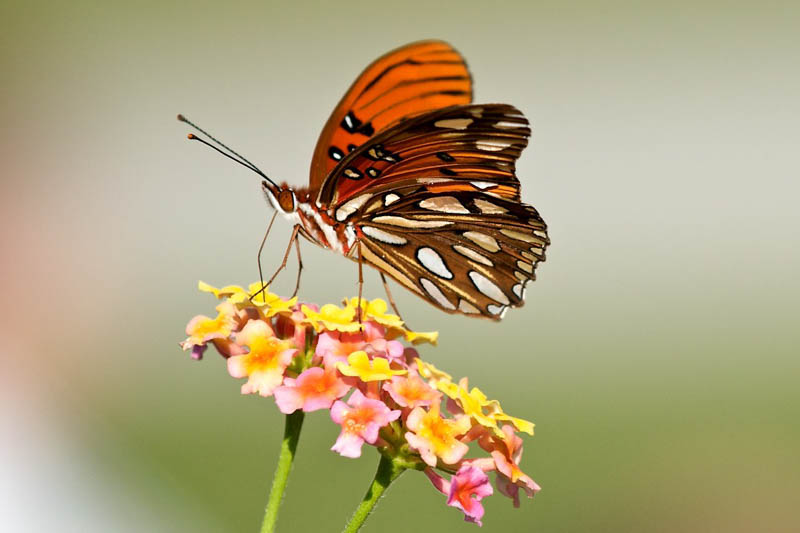
The Gulf Fritillary butterfly is known for its distinct and striking appearance, characterized by the following features:
Wings: The most notable feature is its vibrant orange wings, which are bright and eye-catching. The wingspan of the Gulf Fritillary typically ranges from 2.5 to 3.8 inches (6.3 to 9.5 cm).
Wing Markings: The upper side of the wings is adorned with black markings that contrast sharply with the orange background. These markings are a mix of spots and streaks, giving the butterfly a distinctive pattern.
Underside of Wings: The underside is equally striking, with large, silvery-white spots set against a background ranging from bright orange to a more muted brown-orange hue. This pattern provides a form of camouflage when the butterfly is at rest with its wings closed.
Body and Antennae: The body of the Gulf Fritillary is slender and typically dark in color, complementing its wings. Its antennae are long and thin with small knobs at the ends.
Sexual Dimorphism: There is some variation between males and females. Males are slightly smaller and have brighter coloring, while females have larger, more elongated wings with more pronounced markings.
Caterpillar Appearance: Before reaching this striking adult stage, the caterpillar is notable for its bright orange body with black stripes and numerous black spines, which serve as a deterrent to predators.
The Gulf Fritillary’s vivid coloration is not just for show; it warns predators about its unpalatable taste, a defense mechanism known as aposematism. This butterfly’s distinct look makes it easy to identify and a favorite among butterfly enthusiasts and gardeners.
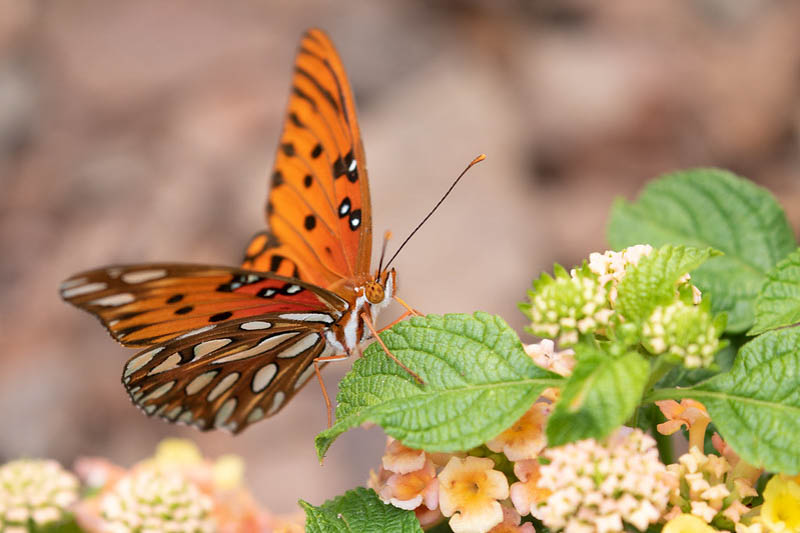
The courtship and mating rituals of the Gulf Fritillary butterfly are unique and fascinating, involving a series of distinct behaviors and interactions:
Courtship Flight: The male Gulf Fritillary initiates courtship with a special flight pattern designed to attract a female. This often involves aerial acrobatics, such as rapid flying, soaring, and fluttering around the female to showcase his vigor and attract her attention.
Pheromone Release: Male butterflies emit pheromones, which are chemical signals that attract females. These pheromones are crucial in making the male appealing to the female.
Perching and Patrolling Behavior: Males often use perching and patrolling behaviors to find females. Perching males wait on leaves or branches for females to pass by while patrolling males actively search for a mate.
Tactile Interaction: When a male locates a receptive female, he may engage in tactile interactions, such as gently touching her with his legs or antennae. This physical contact is an important part of the courtship process.
Mating: Mating occurs if the female is receptive to the male’s advances. The pair will couple end to end, and the mating process can last several minutes to hours.
Post-Mating: After mating, the female lays eggs, typically on or near the host plant – the passionflower vine. The male may continue to search for other mates.
Role of Host Plants: The availability of host plants, like passionflower vines, can influence courtship and mating, as females often lay eggs on these plants. Therefore, the presence of these plants can increase the likelihood of mating success.
Multiple Mating: Female Gulf Fritillaries may mate multiple times throughout their lifespan, a common trait in many butterfly species.
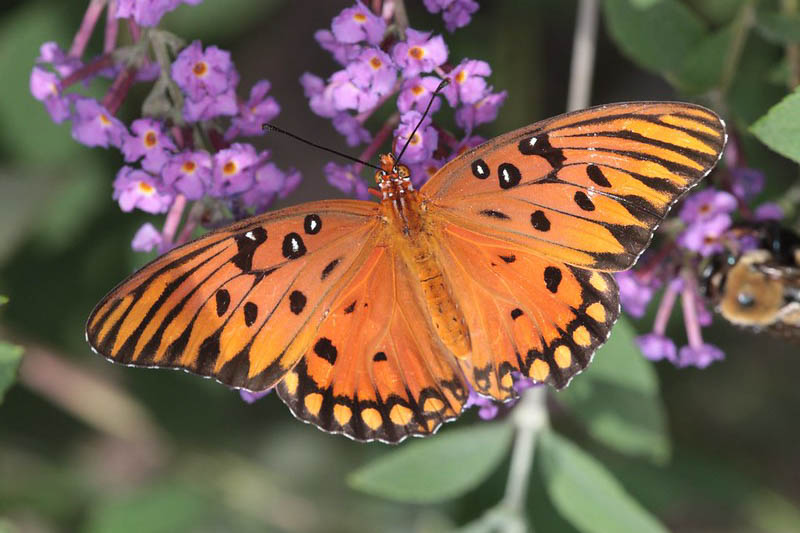
The Gulf Fritillary butterfly undergoes a complete metamorphosis in its life cycle, which includes four distinct stages: egg, caterpillar (larva), pupa (chrysalis), and adult butterfly. Each stage is unique and essential to its development:
Egg Stage: The life cycle begins when a female Gulf Fritillary lays eggs, usually on or near passionflower vines, the caterpillar’s host plant. The eggs are small and yellowish.
Caterpillar Stage: Once the eggs hatch, the caterpillars emerge. Gulf Fritillary caterpillars are notable for their bright orange color with black stripes and spines. These caterpillars feed voraciously on the leaves of the passionflower vine, growing rapidly and shedding their skin multiple times as they develop.
Pupa Stage: After reaching a sufficient size, the caterpillar forms a chrysalis. This pupal stage is a time of transformation, where the caterpillar undergoes significant changes. The chrysalis is typically attached to a plant or other structure and can vary in color from green to brown, providing camouflage.
Adult Butterfly Stage: The final stage is the emergence of the adult Gulf Fritillary butterfly. After emerging, the butterfly will spend time expanding and drying its wings before it can fly.
The duration of the Gulf Fritillary’s life cycle can vary depending on environmental conditions like temperature and humidity. In warmer climates, this cycle can be completed in just a few weeks, allowing for multiple generations in a single year.
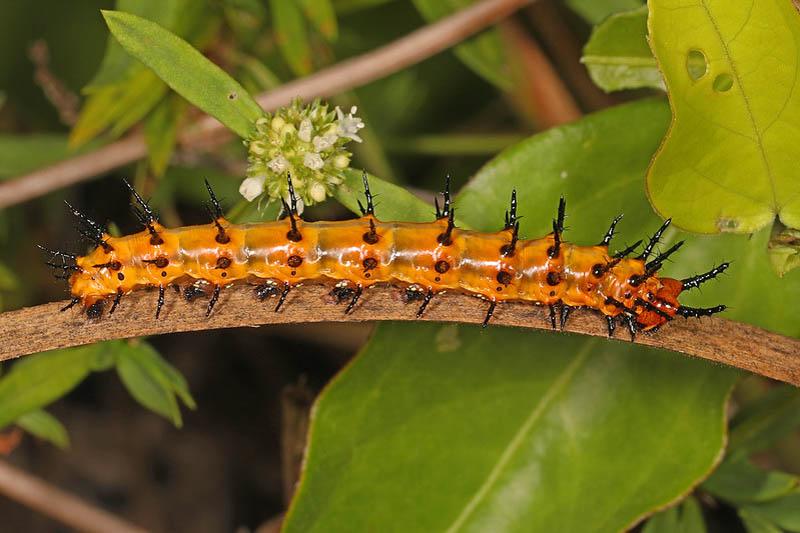 Gulf Fritillary Caterpillar
Gulf Fritillary Caterpillar
The diet of the Gulf Fritillary butterfly varies significantly between the caterpillar and adult stages:
Caterpillar Stage: Gulf Fritillary caterpillars feed exclusively on the leaves of passionflower vines (Passiflora species). These plants contain specific compounds that caterpillars can tolerate and use for defense. The caterpillars rely on these leaves for all their nutritional needs until they are ready to pupate. Buttonsage (Lantana involucrata) is also a larval host plant.
Adult Butterfly Stage: Adult Gulf Fritillaries visit a variety of flowering plants to feed on nectar, which provides them with energy. They are attracted to various flowers, including lantana, aster, thistle, black-eyed Susan (Rudbeckia hirta), coreopsis, and other nectar-rich plants commonly found in gardens and natural landscapes.
In both stages, their food choices are crucial for survival. The passionflower vines provide necessary nutrients and chemical defenses to the caterpillars, while nectar from various flowers supplies the adults with the energy needed for flight, mating, and egg-laying.
The Gulf Fritillary butterfly exhibits distinctive flight patterns and migration behaviors:
Flight Pattern: The Gulf Fritillary is known for its graceful and agile flight. Its flight is characterized by rapid wingbeats and gliding, enabling it to navigate various landscapes, including gardens, fields, and forest edges.
Migration: Unlike some butterfly species known for long-distance migrations, such as the Monarch butterfly, the Gulf Fritillary does not typically engage in extensive migratory movements. However, there may be local and regional movements in response to changes in weather conditions, food availability, and habitat. In Florida, Gulf Fritillaries experience two significant flight periods annually. The initial migration sees vast numbers of these butterflies journeying northward, while the latter migration involves their southward movement across the state, particularly in the peninsula region. These migratory flights typically occur in spring and fall, respectively.
Overwintering Strategy: In regions with milder winters, adult Gulf Fritillaries may remain active year-round. In colder areas, they may not survive the winter, and the population depends on repopulation from warmer regions each year.
Climate and Habitat Influence: Environmental factors such as climate change, habitat destruction, and the availability of host and nectar plants significantly influence the Gulf Fritillary’s flight patterns and distribution. Warmer climates and suitable habitats support larger and more stable populations.
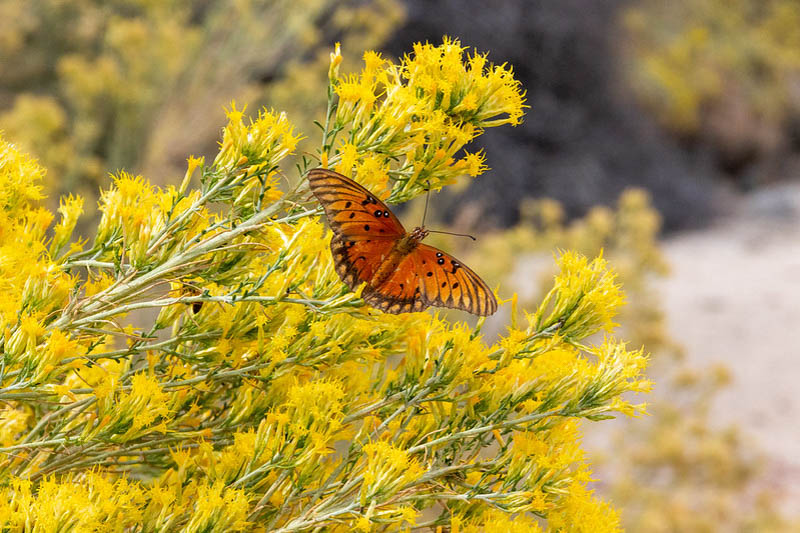
The Gulf Fritillary butterfly, like many butterfly species, has several natural predators across different stages of its life cycle:
Birds: Birds are among the primary predators of Gulf Fritillary butterflies, particularly targeting them in their adult stage. The bright coloration of the butterflies may serve as a warning sign to some birds about their unpalatability.
Spiders: Spiders can capture and eat Gulf Fritillary butterflies, especially adults that get caught in their webs.
Parasitic Wasps and Flies: These insects can be significant predators of the caterpillar stage. Parasitic wasps and flies lay their eggs on or inside the caterpillars. The emerging larvae then feed on the caterpillar, often leading to its demise.
Small Mammals: Rodents such as mice and squirrels may sometimes prey on Gulf Fritillary caterpillars and pupae.
Amphibians and Reptiles: Frogs, toads, and lizards might also prey on Gulf Fritillary butterflies, particularly in regions where such predators are common.
Insect Predators: Certain insect species, including ants and predatory beetles, may attack and eat the eggs and young caterpillars of the Gulf Fritillary.
The Gulf Fritillary has developed several defense mechanisms to reduce predation risks. For example, the caterpillars feed on passionflower vines, which contain toxic compounds that make them less palatable to some predators. Moreover, the adult butterflies’ bright coloration can warn of their potential toxicity or unpalatability. Despite these defenses, predation is a natural part of their life cycle and controls their population within ecosystems.
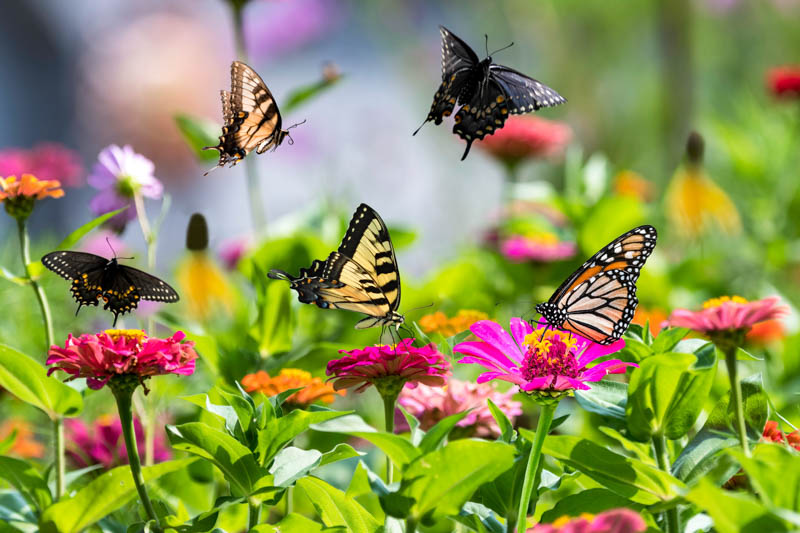
Attracting Gulf Fritillary butterflies to your garden involves providing the resources they need throughout their life cycle. Here are key steps to create a suitable habitat for these vibrant butterflies:
Plant Host Plants for Caterpillars: Since Gulf Fritillary caterpillars exclusively feed on passionflower vines (Passiflora species), planting these is essential. Buttonsage (Lantana involucrata) is also a larval host plant. Including various passionflower species in your garden will provide a food source for the caterpillars and encourage the butterflies to lay eggs.
Provide Nectar Sources for Adults: Adult Gulf Fritillaries need nectar for energy. Planting various nectar-rich flowers such as lantana, aster, thistle, black-eyed Susan (Rudbeckia hirta), coreopsis, and other butterfly-friendly flowers will attract adults. Ensure continuous bloom throughout the season for a steady nectar supply.
Create a Sunny Habitat: Butterflies generally prefer sunny locations. Choose a spot in your garden that receives plenty of sunlight for most of the day.
Offer Water Sources: Include shallow water sources like birdbaths or puddles for butterflies to drink and extract minerals. A damp area with sand or mud can serve as a puddling spot for them.
Avoid Pesticides: Pesticides can be harmful to butterflies and caterpillars. Use organic gardening practices and natural pest control methods to ensure a safe environment for the butterflies.
Shelter and Resting Places: Provide shelter from strong winds and resting places for butterflies. Shrubs, tall grasses, and other plants can offer protection and resting spots.
Garden Maintenance: Maintain a butterfly-friendly garden by allowing some wildness. Avoid over-pruning and let some areas grow naturally to provide habitats for caterpillars and pupae.
Education and Observation: Educate yourself about the specific needs of Gulf Fritillary butterflies. Observing their behavior in your garden can give you insights into their preferences and help you make your garden more butterfly-friendly.
Create a membership account to save your garden designs and to view them on any device.
Becoming a contributing member of Gardenia is easy and can be done in just a few minutes. If you provide us with your name, email address and the payment of a modest $25 annual membership fee, you will become a full member, enabling you to design and save up to 25 of your garden design ideas.
Join now and start creating your dream garden!
Create a membership account to save your garden designs and to view them on any device.
Becoming a contributing member of Gardenia is easy and can be done in just a few minutes. If you provide us with your name, email address and the payment of a modest $25 annual membership fee, you will become a full member, enabling you to design and save up to 25 of your garden design ideas.
Join now and start creating your dream garden!